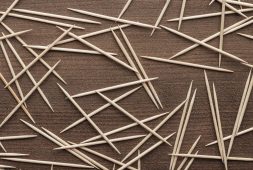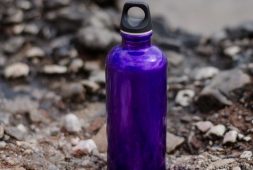Topic: Body of Christ, Unity, focus on Christ
Main Point: Together we make up the body of Christ, and we are part of His great plan.
Attention Grabber: Painting of Christ- painted by the students
This activity could be used to illustrate many things. It could be an Easter activity to focus on Christ. I like to use it as a way to talk about the body of Christ.
We did this in our youth group with great success. It involves worship, a message, and a painting of Christ that the students paint. In the back of the room, there are two canvases. The students are unaware that the two canvases are actually two halves of a larger picture. The canvases are sectioned off and labeled, just like a paint-by-number picture. The students are dismissed to the back of the room, and they get to paint a section of one of the canvases. At the end of the evening, the two paintings are brought to the front and placed together, forming a picture of Christ. This illustrates that with each person being a brush stroke, we all make up the body of Christ together.
Paint-By-Number Materials:
I downloaded the program Color By Number 2.0 by STOIK Imaging from this website: click here (stoik.com/hobby/colorbynumber.htm) The program costs about $20. There are other programs out there, and possibly cheaper ones, but this is what we used. This program will turn any picture into a paint-by-number picture. There are many pictures of Christ that would work, just “Google” search and find a picture that you think your group would like to paint. When you enter the picture into the Color by Number program, you will have an option of choosing how many colors and of what brand you would like. On our picture, we used “Bruynzeel Design Fullcolor” brand, with only 4 colors. The colors the program chose were all shades of grayish-brown, but when painting we used three shades of brown: Light brown, dark brown, black, and blank canvas (or white). Once you have the picture you like, print the color by number picture. Then you can use an overhead projector to blow it up onto a sheet of canvas and draw it. We then cut the picture in half (hamburger cut, not hotdog cut), and put both halves on frames so that they could be fastened together later. After getting the paint and brushes, we were ready to paint. I would recommend printing up a smaller scale of the paint-by-number model and then using colored pencils or markers to color it, just to make sure you know what to expect. Here is the order of the evening:
Opening Statement:
Tonight we’re going to be talking about God’s plan in our lives. Did you know that God has placed you right where you are for a reason? Did you know that you are exactly who God created you to be? Some people I know have actually been angry with God because they weren’t created pretty enough or smart enough or because there was something else wrong with them. Or they were mad at God because their family didn’t make as much money as some of the other families they know. But have you ever thought about how much God knows and how powerful God is? Is it possible that God has you where you are for a reason? Right now take a second and think about your life. Think about who you are. Think about where you go to school and where you live. Think about where you go to church. Why is it that God has put you here? We’re going to sit in silence for a couple minutes. Use this time to ask God why He has put you where you are. Spend some of this time to thank God for knowing His plans.
Transitional Statement (after silence):
I am so glad that God has made me like I am. But I’m even gladder that not everyone else is like me. If this world had nothing but people just like me, I’d want to leave right now. Isn’t it great how God has made us all different? The Bible says that we’re all different for a reason. 1 Corinthians 12:12-17 says,
- “The body is a unit, though it is made up of many parts; and though all its parts are many, they form one body. So it is with Christ. For we were all baptized by one Spirit into one body—whether Jews or Greeks, slave or free—and we were all given the one Spirit to drink.
Now the body is not made up of one part but of many. If the foot should say, ‘Because I am not a hand, I do not belong to the body,’ it would not for that reason cease to be part of the body. And if the ear should say, ‘Because I am not an eye, I do not belong to the body,’ it would not for that reason cease to be part of the body. If the whole body were an eye, where would the sense of hearing be? If the whole body were an ear, where would the sense of smell be?”
This says that just like our body is made up of different parts, so is the body of Christ. We are all different because we all make up the church. With all our different strengths and weaknesses, we can change this world.
We are now going to spend some time in worship. There are two paintings in the back of the room. They are split up into sections with a number on them. You’ll see there are three different paints with numbers on them. You’ll take a brush with paint on it and paint a section of one of the paintings that has the same number on it. Be sure to stay in the lines. It’s very important. And while you paint your section, think about the brush stroke of your life. If this world is one huge painting, what does your brush stroke look like? We’re going to spend some time singing right now. Stay with your small group, and we’ll dismiss you by group to go paint.
Painting the Picture:
In order to “disguise” the finished product of the painting, we cut the painting in half. The top half of the picture (Jesus’ eyes and forehead) was turned sideways so it looked more like a colon (:). The other half was turned upside down so Jesus chin now looked like a hill. We set the two paintings on large round tables, and placed the paint between them. The paint cans and the brushes were all numbered. There were at least two adult volunteers at each of the two tables, making sure students were painting the right sections the right colors. We also had one or two of the leaders painting in some of the more difficult or critical sections (such as the pupils of the eyes, etc.).
The closer the paintings get to being finished, the fewer students there should be around them. Let the volunteers finish up the rest of the paintings, “cleaning them up” a bit. This can happen at the beginning of the wrap up discussion. This last phase is critical. The volunteers helping can also spread out and even lighten some of the paint that may be too thick to dry. The goal is to make the painting look as much like the original as possible.
During the wrap-up, the two paintings are going to be brought up and joined together in front of the students. Some of them might have guessed, but the majority of the students will be in awe. We knew exactly what was going to happen and what it was going to look like, and we were still surprised.
Reflection Questions:
While the students are painting the picture and the rest are singing worship songs, it’s a good idea to interrupt worship periodically with questions the students can reflect on. You may even ask the same questions you asked in the opening statement:
- Why has God put you where you are?
- What are your strengths and weaknesses? Have you thanked God for your strengths?
- How can God use you in the youth group?
- How can God use you in your school?
Wrap-Up:
Isn’t it amazing that God has given us an opportunity to be used by Him in this world? I love that we are all part of this body of Christ. When I look at God and at how great He is, I am amazed that He chooses to use me. Sometimes I feel so insignificant. I look at my life and really ask, “God, why can’t I see what you’re doing?” It seems as if my life is just a brushstroke. I am insignificant. But listen to what Paul says in 1 Cor. 12:21-25:
- “The eye cannot say to the hand, ‘I don’t need you!’ And the head cannot say to the feet, ‘I don’t need you!’ On the contrary, those parts of the body that seem to be weaker are indispensable”—this means that we need them, we can’t throw them away—“and the parts that we think are less honorable we treat with special honor. And the parts that are unpresentable are treated with special modesty, while our presentable parts need no special treatment. But God has combined the members of the body and has given greater honor to the parts that lacked it, so that there should be no division in the body, but that its parts should have equal concern for each other.”
But for me, sometimes it’s hard for me to see that I’m useful. And I know people that look at junior highers (or high schoolers) and say that they’re too young to be used by God. Do you truly believe that you are significant? Do you believe that you really are this “indispensable” piece of the body of Christ?
Let’s look at one of those paintings. (At this point one volunteer brings up the bottom half of the picture. Chances are, the students won’t recognize what the picture is of.) A lot of you have put a brush stroke on this canvas. Maybe you’re looking up at this picture and you can actually see the part that you painted. But so what? Why would it be so important for you to do your part? Why is it so important that I’m a part of this body of Christ?
(And now, when you start reading this next passage of Scripture, the volunteer will bring up the other half of the picture and attach it to the bottom when the word “arranged” is read.)
But remember, God has put us where He wants us. Here’s what Paul says: “If the whole body were an ear, where would the sense of smell be?” Do you remember this part? But then he says, “But in fact God has arranged the parts in the body, every one of them, just as he wanted them to be.”
(Now is a time for a brief pause in everything while the students realize that they have all together painted a picture of Christ.)
You see, we can’t see the main picture. All we have is this little brush, this little section of a great big painting. But even though we can’t see the whole picture sometimes, it doesn’t mean that God can’t use us. In fact, our brushstroke is significant. God wants to use us. Every single person who stroked a brush across this canvas just added a piece. Is there any brush stroke that was more important than the others? Of course not! We are all significant. God wants to use all of us. No matter where you are in this world, no matter what your strengths or your weaknesses are, God can and will use you. Don’t give up on that.
A Letter of Encouragement:
This seems like it’s a lot of work. But in reality it isn’t too bad. It took about a day to get the picture just like we wanted it on the Color By Number program, and then another day to trace the picture onto canvas, build the frames, and color a sample. The effect of the painting coming together and all of the “oohs” and “ahhs” was amazing. The room went absolutely silent after the initial gasps. Now we display the picture every week, and the students remember that they are a part of something great.
Written by Matt Furby
Jonathan McKee
Jonathan McKee is the author of over twenty books including the brand new The Guy's Guide to FOUR BATTLES Every Young Man Must Face; The Teen’s Guide to Social Media & Mobile Devices; If I Had a Parenting Do Over; and the Amazon Best Seller - The Guy's Guide to God, Girls and the Phone in Your Pocket. He speaks to parents and leaders worldwide, all while providing free resources for youth workers on TheSource4YM.com. Jonathan, his wife Lori, and their three kids live in California.



